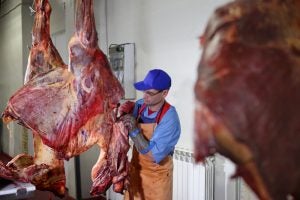Have you ever been hungry enough to eat a horse? Despite the polarization and deep emotions surrounding horse slaughter, horse meat has been an intermittent part of American diets when wars and rationing necessitated a high-quality, affordable protein. Less squeamish countries, however, have long-considered horse meat a regular staple. In fact, over 50 percent of the world’s population consumes horse meat regularly.
The horse didn’t find its place as a beast of burden until the last 5,000 years. It’s beginnings in human culture were, instead, as a protein-packed prey. After domestication, many cultures continued to consume the horses they were not using for pleasure or transportation as food.
So, if Americans have eaten horses and other countries continue to, why is horse slaughter such a hot-button topic in the United States?
View this post on Instagram
Countries that eat horses
The top 10 horse meat-producers order are China, Kazakhstan, Mexico, Mongolia, Russia, the United States, Canada, Brazil, Australia, and Kyrgyzstan.
Surprisingly, although horse meat is consumed in most of Europe and Asia, there are a few countries that stray away from eating horse. For example, the United Kingdom abhors horse meat, sharing sentiments similar to many Americans, while Germans and South Koreans are also known to turn their noses up at horse dishes.
In Asia, the Japanese raise draft horses for meat production and import live horses from Canada, Mexico, Italy, Argentina, and Brazil. Their people enjoy raw horse meat, known as sakuraniku, served as sashimi and basashi. Kazakhstan and Krygzstan, mostly nomadic people, consider horse meat a primary part of their diets in the form of sausage, smoked and boiled hip and jaw meat, and karma, a dish made from the smoked and boiled rectum. Another Asian county that considers horses a delicacy is Indonesia, where sate kudos, a skewered, grilled meat in spicy sauce, is revered for increasing a man’s strength and vitality. Mongolians also consume and export horse meat.
Popular European dishes include the Austrian Leberkäse, served in bread rolls or with dumplings, Belgium’s smoked, sliced, cold cuts known as paardenrookvlees, horse steaks, a stew named schep, and sausage. Bulgarians prefer horse in a steak and burger, and the Fins are partial to horse sausages, especially meetwursti, a sausage with pork, beef, and horse meat. Hungarians love horse salami and sausages mixed with pork, goulashes, and horse stews. Italians also enjoy horse and donkey meat, while the Spanish have been known to eat foal meat or carne de port.
View this post on Instagram
Horse meat is widely regulated
Canada and Mexico are the United States’ largest exporters of horses for slaughter. The Canadian Food Inspection Agency oversees all meat and poultry products. The CFIA ensures that all products are safe for human consumption and produced within the scope of Canadian regulation while verifying that licensed slaughter operations handle horses with care and follow federal laws regarding humane treatment and safe processing. Canadian law requires that all animals, including horses, are treated humanely throughout the slaughter process.
The Safe Food for Canadians Act ensures that meat products are inspected, tested for pesticides and drug residue, and properly killed by captive bolt gun. Health Canada regulates veterinary drugs in horses — all equines must have a vaccination and medication record, called an Equine Information Document, for six months before slaughter. Phenylbutazone, or “bute” in particular, is not approved for use in food animals. The CFIA has been testing horse meat since 2002 and has had few issues with compliance rates for drug residues.
There are two facilities in Zacatecas, Mexico — both of which are federally inspected, but only one that meets both Mexican and European standards. The European Union requires all imported horse meat to have been killed by a captive bolt gun before bleeding — captive bolt methods are utilized in processing other livestock animals, including cattle, goats, and sheep. Horses are transported from the United States in sealed trailers. Upon arrival, one of five on-site veterinarians cuts the seal and authorizes euthanasia of any horses severely injured during transportation. Products are randomly tested for drug residues, parasites, and bacterial infections such as Escherichia coli and salmonella.
“If you look at it from the hard perspective of the meat industry, they’re in the business to produce meat. They don’t want an injured or down or stressed horse any more than they have to, because it affects the meat quality,” Dr. Tom R Lenz, former president of the American Association of Equine Practitioners, said after touring the Zacatecas facilities in 2009.

But, why horses?
A British writer named Mathew Fort summed it up: “The taste for donkey and horse goes back to the days when these animals were part of everyday agricultural life. In the frugal, unsentimental manner of agricultural communities, all the animals were looked on as a source of protein. Waste was not an option.”
Proponents of horse meat often refer to it as chevaline. Compared to beef, horse meat contains similar levels of protein and much lower fat levels. It also is higher in essential fatty acids such as palmitoleic acid and α-linolenic acids than beef and pork — plus, it costs less.
Horse meat fans tout it as sweeter than beef, slightly gamey, tender, and delicious. Alex Renton from The Guardian said, “I went to a steak tasting at Edinburgh’s L’Escargot Bleu bistro. … Chef and patron Fred Berkmillar had packed in 12 Scottish foodies, cooks and meat suppliers and gave us rump steaks to try. One was the best 30-day-aged Orkney beef, the other Comtois horse, farmed in the Dordogne.
You could have confused the horse with beef, but its steak — juicy, tender, just slightly gamey — won the fry-off by 12 votes to none.”
Even celebrity chef, Gordon Ramsey, jumped on the horse meat bandwagon, sharing a controversial 22 ways to cook horse meat – Italian Cuisine list of recipes and cooking tips.
Horses were on the American menu not long ago
During World War I, Congress authorized the U.S. Department of Agriculture to inspect horse meat. Although a break between wars found beef back on American’s menu, beef and other meat sources once again became more challenging to find during World War II. During WWII, government-inspected horse meat was not rationed. More readily affordable and available horse products again became a primary protein.
According to The New York Times, in 1973, inflation again brought horse meat to the regular American menu. Carlson’s, a butcher shop in Westbrook, Connecticut, reported selling 6,000 pounds daily. Although no longer in print, you can still find Carlson’s Horsemeat CookBook on Amazon. Until 1985, horse meat was on the menu at the Harvard Faculty Club.
So, why is horse meat not on the menu now? Americans love horses — they just don’t love the thought of eating them. The image of the horse is romanticized by such movies and television shows as Black Beauty, Spirit, My Little Pony, and The Black Stallion, and by the tens of thousands of animal-rights activist groups worldwide.
Some of the most extreme activist groups are centered in the United States. They include the American Society for the Prevention of Cruelty to Animals, the Animal Welfare Institute, Humane Society of the United States, the Humane Society Legislative Fund, and Return to Freedom Wild Horse Conservation. These groups do an effective job of convincing the general public that horse slaughter is an animal welfare issue, touting it as an inhumane practice that yields a product unfit for human consumption. As a result, the general public and these animal welfare groups tend to regard horses as pets, even though they don’t live in our houses or sleep in our beds. The 2018 Farm Bill officially classified horses as livestock.

Although it isn’t illegal to consume chevaline, multiple state and federal legislative actions have blocked the processing and commercial sale of horse meat in the United States, making it difficult to come by. However, as recently as 2006, plants in Texas and Illinois were slaughtering over 100,000 horses yearly.
In 1998, California passed a ban on horse slaughter and the sale of meat. Since 2005, federal laws have gone back and forth, ultimately circumventing the reinstitution of domestic horse slaughter. Animal scientist Temple Grandin discussed the issue of closing domestic facilities at large, saying that USDA-regulated facilities could be designed specifically with the horse’s welfare in mind.
Federal court action effectively closed the Texas plants in 2007, and a ban in Illinois closed the plant in that state. The Agriculture Appropriations Bill for 2012 was passed by Congress and signed into law without the wording that had prohibited horse meat inspections since 2006. Following this allowance, in 2013, a facility named New Mexico Valley Meats, located in Roswell, New Mexico, became the first horse processing plant approved by USDA since 2007. This plant never opened.
The year 2014 saw a new federal budget with language prohibiting horse slaughter passed by Congress and signed into law by President Barack Obama. An inspection ban that was eventually lifted in 2017 prohibited the federal funding of horse inspections for several years.
Despite opposition, tens of thousands of horses continue to be exported to Canada and Mexico for slaughter, even with recent bills introduced in 2021 to halt exports.

The Horsemeat Cookbook, Amazon
The U.S. has horses galore
The United States boasts an abundance of domestic and wild horses. While cattle are carefully managed on public lands, hundreds of thousands of wild horses range these lands primarily unmanaged. Wild horses utilize resources that native wildlife and cattle use; they’re also eating up tax dollars. Other native and non-native species are managed and funded through lawful hunting; however, the horse remains immune to this management strategy. The federal Bureau of Land Management has attempted to manage wild populations for decades through methods such as gathering and adoption. However, nearly 50,000 horses remain housed in BLM facilities, while the rest continue to multiply and use precious, natural resources.
Like in any other species, breeding for specific traits will result in an undesired population of animals — this is where culling happens. Much like natural selection, culling allows breeders to select for specific traits that make modern horses desirable for whatever their chosen job is. This practice keeps the best animals in the genetic pool, and removes animals with undesirable traits from the system.
While the idea of rescuing all of these undesirable horses may seem ideal, the average person either does not have the resources or the knowledge to properly care for these large animals. In addition, the bottom dollar presented for slaughter horses gives all relatively healthy horses an easy, base value. Without horse slaughter and exports, a horse is only worth as much as someone is willing to pay. The national average for small grass bales is up to $330 per ton, which means that the average horse costs at least $1,200 per year to feed. That’s without supplemental feed, hoof care, veterinary care, training, boarding, and so much more. If even the the BLM cannot place all of their overstocked, unwanted horses, where should the unusable and unwanted domestic horses go?
With fewer people willing and able to adopt unwanted horses, euthanasia may seem like a humane option. Unfortunately, euthanasia drugs present environmental toxicity issues along with the volume of carcass disposal that the United States would face if even exports for slaughter were not an option. While Americans love their horses, horse meat may not always be a “no-go,” and exports for slaughter remain a viable resource for a population of horses no longer valued for their companionship and usefulness.

Heidi Crnkovic, is the Associate Editor for AGDAILY. She is a New Mexico native with deep-seated roots in the Southwest and a passion for all things agriculture.



